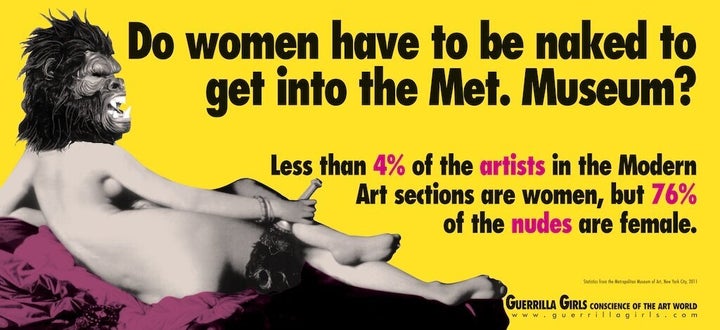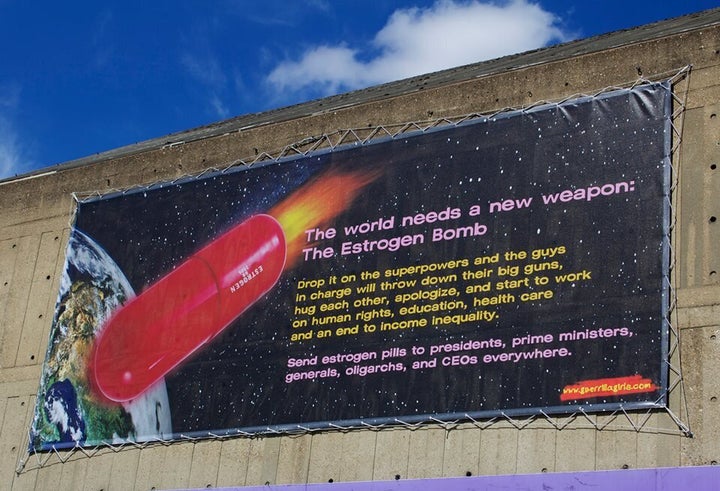
Formed in 1985 in response to the underrepresentation of women artists in New York's Museum of Modern Art, the Guerrilla Girls offered a performative and political opposition to sexism in the art world. I sat down with two of the founding members of the Guerrilla Girls, pseudonyms Frida Kahlo and Käthe Kollwitz, during the first days of Yoko Ono's Meltdown and we spoke about the current state of feminism and the branding within the art world.
Vigo: How do the Guerrilla Girls deal with the fact that feminists today are still viewed as 'old school' despite the persistent knowledge that women are still underrepresented in the world?
Kahlo: We think it's totally crazy that people refuse to call themselves 'feminists' due to the fact that it has been demonised for so long in the media when they believe in the ideas of feminism. So many people do. And feminism 'don't get no respect.' It is one of the greatest human rights movements of our time along with civil rights, GLBT rights. It's equally important and equally world-changing like all those other movements.
Vigo: According to your recent count in 2012, 4% of artists represented and 76% of the nudes in the Modern Art sections of the Metropolitan Museum of Art are women. You have been around twenty-eight years and the face of art has not changed radically.

Kollwitz: What we found is that in 1984, when we first started, there were very few women even represented by galleries and at museums. I think people realise that you can't write a history of a culture without all the voices in a culture, otherwise it is just history of the powerful within a culture. However, there are other forms of discrimination and exclusion that are functioning. First, there is tokenism. A lot of places believe that if they show a handful of women and artists of colour, a handful of gay, lesbian and bi artists, that this is ok. Also there is a tremendous economic inequality between women and men artists. White males are absolutely at the top. The highest record price for an artwork by a man is ten times higher than the record price for an artwork by a woman. Now we are talking about millions of dollars so that is a whole stratosphere that a lot of people don't even get. But that is so far below what women make in the general economy that it is just stunning. The art world really lags behind the culture at large.
Kahlo: That said we have always had people in our group who've always wanted a piece of the pie so to speak; but we have had lots of other people, including some here, who wanted to blow up that fucking pie and get a new pie. The system sucks! The world of artists, writers and curators is great. The system is the worse it has ever been. It's all about anointing the few. Collectors basically all have the same collections. What does that mean 100 years from now when you look back at museums? They're just all going to have Charles Saatchi's collection--that's it.
Kollwitz: Part of that is the economy of the art market which has created art as a 'commodity' or as an 'investment instrument.' So you find collectors all vying for the same work and driving up the value. It's like a big poker game.
Kahlo: It's gotten corporatised. We have gone after the art world over and over again. We have also done lots of work about politics, the film industry, etc. We take on a lot of issues and see what we can do with them. One thing that has happened to us that is the best thing of all is that we have become a model for people who want to be activists in their own way, who use art and the crazy way of twisting things around and presenting them differently. In that way nobody can solve all the problems but it's kind of a golden age of activism--there is so much creativity and so many crazy ass things going on!
Kollwitz: There is a fundamental difference between museums in the United States and in Europe. In Europe they are an instrument of the government run with public money. In the United States they are private and they are run by the very people who are players in the art world, who are investors in the art world. No one ever looks at this as perhaps a conflict of interest--that an art collector can be on the board of trustees of a museum and be involved in the decisions that affect the value of their very own collection. The aura of art excuses that behaviour but it wouldn't be tolerated in other areas of the economy.
Vigo: Is it really that surprising that we have the advertising agency approach to art?
Kahlo: Branding. Artists have to brand themselves now. It is more corporate than it has ever been before. On the other hand artists are still totally committed to their work, they put their whole lives into it. Sure, there is insider trading, there is criminality of all sorts. A lot of the same corporate people are on the boards of these art museums.
Kollwitz: It is also the fact that traditionally art is a precious object that exists in one place at one time. It is not like books or music or film which can be reproduce, which cannot be owned in the same way that art can be owned. So there is a real structural problem there and a lot of artists who would like to change the world still participate in that market. We are really proud that we have a different economic structure in our organisation. We are in art history books but we don't have dealers. Our prices don't go up.
Kahlo: We make cheap art.
Kollwitz: We believe in a lot of small exchanges: t-shirts, books, posters. It's really a new paradigm and we are really proud of this. We are also activist models and we hope we can be models for visual artists who invent some new way for their work to be owned and to exist in the world. We are happier that our posters are in every college dormitory room in the United States than hanging in the living rooms of Charles Saatchi and rich collectors in the United States.

Vigo: Does this method democratise art?
Kollwitz: We hope so.
Kahlo: You know we are activists and artists--you can't separate the two things. The Guerrilla Girls had an idea to put two posters up on the streets of New York twenty-eight years ago. All hell broke loose and everything we have done since then is spinning out our idea of how to craft political art from one thing to another thing to another thing. We are so lucky to be doing this work, lucky that people care about it and lucky not to be part of that corrupt system.
Vigo: Tell me about your 'gender reassignment' project.
Kollwitz: We are looking for a museum that will allow us to do that on the façade. It could be as harmless as a video projection or a banner. We would love to do it. There are plenty of museums in Europe--especially in London--which are in that condition. And if they were really advanced they would let us do it.
Kahlo: We have an outdoor banner and we do street projects all over the place--we did one against hate speech in Montreal. As well, we have to admit, the art world has come calling us so we do appearances and exhibitions. That caused us a little soul searching because we like being the outside agitators. I mean you wouldn't be a Guerrilla Girl if that wasn't who you were at bottom in your soul.
Copyright © Guerrilla Girls
Courtesy www.guerrillagirls.com
